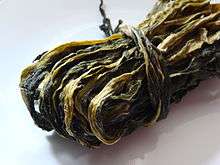Meigan cai

Meigan cai (simplified Chinese: 梅干菜; traditional Chinese: 霉乾菜; pinyin: méigān cài; Wade–Giles: mei2-kan1 ts'ai4; literally: "molded dried vegetable"; or mei cai (simplified Chinese: 梅菜; traditional Chinese: 霉菜; pinyin: méi cài; Wade–Giles: mei2 ts'ai4) is a type of dry pickled Chinese mustard of the Hakka people from Huizhou, Guangdong province, China. Meigan cai is also used in the cuisine of Shaoxing (绍兴), Zhejiang province, China and in Taiwan.
The pickle consists of a whole head of various varieties of Chinese mustards and cabbages (芥菜 (leaf mustard)、油菜 (rape)、白菜 (Chinese cabbage) that has undergone an elaborate process consisting of drying, steaming, and salting. The vegetables are harvested, trimmed before the Qingming Festival, and sun-dried until limp. It is then salted or brined, kneaded until the juices are exuded, and left to ferment in large clay urns for 15 to 20 days. The vegetable is then repeatedly steamed and dried until reddish brown in colour and highly fragrant.
This pickled vegetable is used to flavor stewed dishes, in particular Meigan cai cooked with pork (梅菜扣肉/梅干菜烧肉)) or for Meigan cai baozi (梅菜菜包). Meigan cai was formerly a tribute item to the imperial palace in the Qing Dynasty.